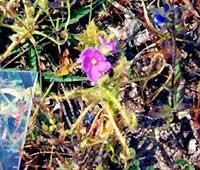| Period: 17 May -
15 December 2003. Country: Laos |
| (1) Structure and Distribution
of Vegetation Under Human Disturbance in Savannakhet Province,
Laos |
| KOSAKA Yasuyuki (Division
of Southeast Asian Area Studies) |
| Key Words: Deforestation,
Natural Resources Use, Secondary Succession, Paddy Fields,
Shifting Cultivation |

Photo 1: Habenaria rostellifera (Orchidaceae) |

Photo 2: Drosera indica (Droseraceae) |
(2) Hilly plains spread over midland Laos and northeast Thailand. Dry dipterocarp forests, mixed deciduous forests, evergreen forests and their substitutive communities can be found on the undulating terrain consisting of Mesozoic era red sandstone. However, few studies have been conducted on the impact of human disturbance on those vegetation types. The objective of this study is to estimate the secondary succession pattern of the vegetation and to examine the current conditions of the local land-use system and forest management.
(3) The
latest field survey was conducted at NK village and BK village,
Champhone District in Savannakhet Province, Laos, in June, July,
September, October and December, 2003. Both villages are located
on a continuous slope, with paddy fields spreading over the lowland
from NK village to the center of BK village, with shifting cultivation
being performed on the higher land. Some springs were found near
BK village, which is on the boundary between the paddy field zone
and the shifting cultivation zone. A vegetation survey was conducted
in the paddy field zone, which predominates in the land-use of
both villages.
The
result is that a total of 204 herb species were recorded. It is
believed that the number counted at the two villages is quite large,
considering that only 190 paddy weed species have been counted
from all over Japan [Numata, M. et al., 2002]. In addition, 120
woody species were recorded. The factors contributing to this richness
are examined below.
First,
we considered various aspects of the topography of paddy fields.
Paddy fields are classified into 4 types of landform and 5 types
of soil, with some species occurring site specifically. Plant distribution
is also dependent on micro-landforms such as paddy surface, slope
and flat part of levee, and termite mounds. Next, the existence
of remnant species is noted. Forest trees such as Peltophorum
dasyrrhachis, Pterocarpus macrocarpus etc., forest floor shrubs and herbs such
as Helicteres spp., Habenaria rostellifera etc, and moor plants
such as Drosera spp., Stylidium spp., Utricularia spp. etc. were
observed. In particular, Drosera indica and Stylidium spp. are
described as rare species in Flora of Thailand, indicating that
this study site is a precious habitat for them. Moreover, human
activities also influence the species composition. It seems that
pasturing as well as rice cultivation prevents paddy vegetation
from making the succession to monotonous meadows of grasses or
sedges. In addition, the various relationships between human and
plants, such as the use of wild plants, protection of wild plants
or domestication, and the use of escaped plants, have an effect
on plant distribution.
Reference:
Numata, M., Iwase, T. 2002. "Zusetsu Nihonno Syokusei" pp 240-241. (in Japanese)
Santisuk, T. et al. 1970-. "Flora of Thailand" Vol. 2, pp. 276-277, Vol. 5, pp. 68-69, RFD, Bangkok.
|


 21st Century COE Program
-Aiming for COE of Integrated Area Studies-
21st Century COE Program
-Aiming for COE of Integrated Area Studies-